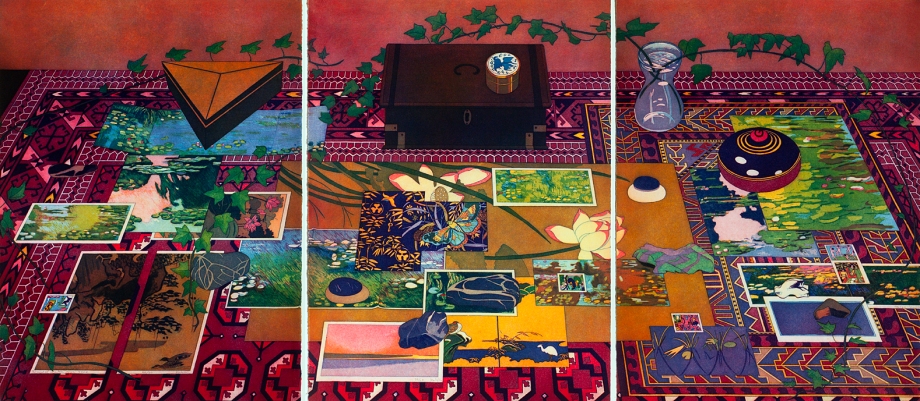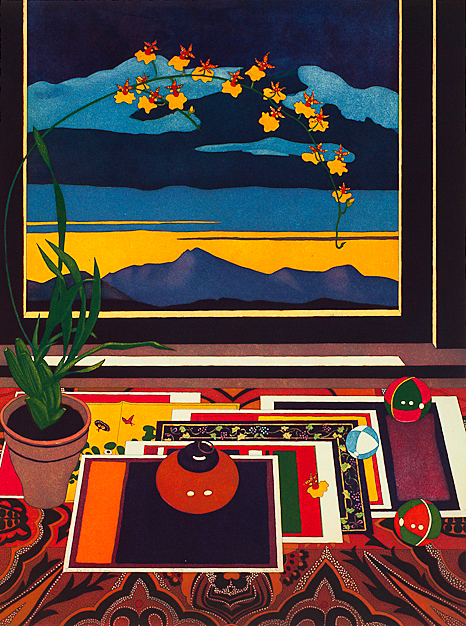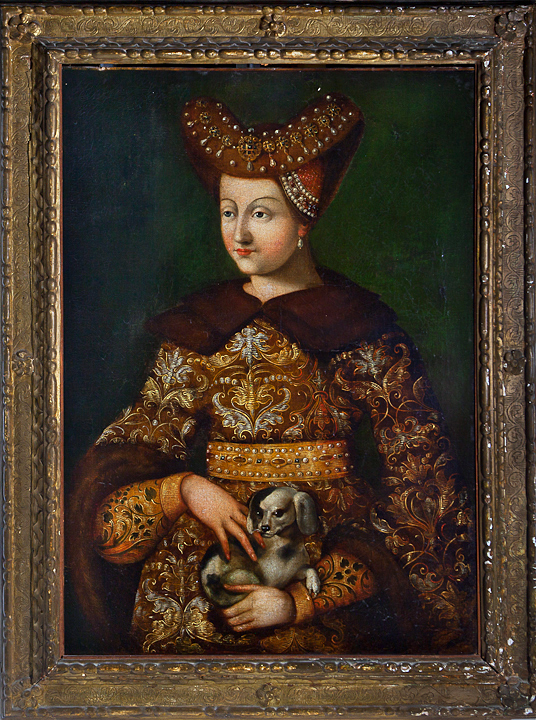The following prints by German-born American artist Katja Oxman joined the collection just last year and are currently on display in the Mead’s New Arrivals exhibition (on view through June 29).
 click to enlarge the image
click to enlarge the image
This beautiful triptych, titled Sound of Water Over Rock, is a meticulously arranged still life. The title, taken from a passage in T. S. Eliot’s 1922 poem “The Waste Land” in which the speaker longs to hear the sound of water over a rock, subtly alludes to the diversity of forms in the print. Similar to Eliot’s complex and excursive poem, Oxman’s print is a mélange of the traditional and the modern, the soft and the sharply cut, the flat and the three-dimensional, the geometric and the impressionistic. Notice, for instance, the contrasts between the rug’s pattern, the renditions of Japanese prints, and Monet’s water lilies.
 This print – In Yellow Hewn – takes its title from nineteenth-century Amherst-born poet Emily Dickinson, who wrote, “Of Yellow was the outer Sky / In Yellower Yellow hewn / Till Saffron in Vermilion slid / Whose seam could not be shewn.” Within the print, one finds the connotation of “hewn” in the way two thin streaks of blue and yellow mirror each other over the mountains, as if indicating that the yellow sky is raggedly dissolving into the approaching night clouds. The window faces west; the table is already sunk in the hues of “Saffron” and “Vermillion.” Colorful postcards depicting well-known artworks on the tabletop and the flowering orchid curving over the scene aesthetically complement the distant sky. Although indicative of Oxman’s customary fondness for strictly structured shapes and her lack of shadows, this mountainous vista nevertheless betrays a pensive depth and hints at a great expanse beyond the confines of the room and the frame of the window.
This print – In Yellow Hewn – takes its title from nineteenth-century Amherst-born poet Emily Dickinson, who wrote, “Of Yellow was the outer Sky / In Yellower Yellow hewn / Till Saffron in Vermilion slid / Whose seam could not be shewn.” Within the print, one finds the connotation of “hewn” in the way two thin streaks of blue and yellow mirror each other over the mountains, as if indicating that the yellow sky is raggedly dissolving into the approaching night clouds. The window faces west; the table is already sunk in the hues of “Saffron” and “Vermillion.” Colorful postcards depicting well-known artworks on the tabletop and the flowering orchid curving over the scene aesthetically complement the distant sky. Although indicative of Oxman’s customary fondness for strictly structured shapes and her lack of shadows, this mountainous vista nevertheless betrays a pensive depth and hints at a great expanse beyond the confines of the room and the frame of the window.
image and text sources: 1 / 2
 The clothing presented in this engaging portrait—a variation of the glamorous style first popularized in mid-fifteenth-century Burgundy—proclaims the sitter’s aristocratic status: her fur-trimmed damask gown is closed with a jeweled golden belt, worn over an embroidered, narrow-sleeved kirtle, and with a “horned” jeweled hennin (or headdress) with red ear cauls. The dog she holds belongs to the breed later called a King Charles Spaniel, which has been linked to the English royal family at least since the early sixteenth century, when the only dogs that Henry VIII permitted at his court were such “small spanyells for the ladies.”
The clothing presented in this engaging portrait—a variation of the glamorous style first popularized in mid-fifteenth-century Burgundy—proclaims the sitter’s aristocratic status: her fur-trimmed damask gown is closed with a jeweled golden belt, worn over an embroidered, narrow-sleeved kirtle, and with a “horned” jeweled hennin (or headdress) with red ear cauls. The dog she holds belongs to the breed later called a King Charles Spaniel, which has been linked to the English royal family at least since the early sixteenth century, when the only dogs that Henry VIII permitted at his court were such “small spanyells for the ladies.” click to enlarge the image
click to enlarge the image